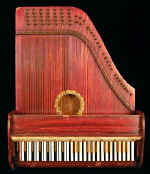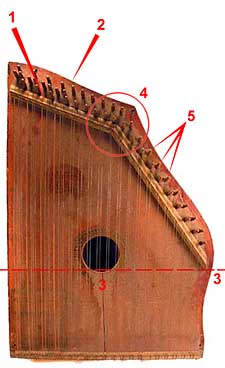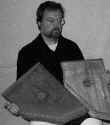In addition to Kelly's theories and my analysis, Garry Harrison (who more or
less agrees) has gone even further and is re-configuring Phonoharps and figuring
out how to tune and play them to approximate Phillips' unique playing. He's got
two pretty amazing MP3s available on his own special
Washington Phillips section. Garry also proposes a new
dual-zither theory (completely plausible, as far-fetched as it sounds!).
A
Homemade Instrument?
In
Michael Corcoran's investigation into the instrument Phillips may have played,
he was focused on evidence to verify or disprove the Dolceola as a candidate. In
this pursuit, he turned up three eyewitnesses who described a "home-made"
instrument. Note 2
He even said that one witness was shown the actual picture of Phillips with the
two Phonoharps, but said "that's not it either." Note 3
Corcoran admitted that he wasn't a musician (and not familiar with the
instruments of this study), while graciously providing me with phone numbers for
some of the key witnesses. After talking with four of them Note 4,
it became clear to me that these relatives and neighbors were simply repeating
the "common knowledge in the community" - essentially communal
folklore - that "Phillips made his
'harp' himself." Corcoran's article(s) leads one to believe that these witnesses had formed the
opinion on their own from personal observation, but this was probably not
generally the case. Indeed, three could not describe the instrument whatsoever. Note 5
But
one could - and did. This was
85-year-old Earl Phillips, a second cousin (with a PHD in Economics), who
definitely recalled a homemade
instrument, and gave me some pretty descriptive clues in a phone conversation on
April 16, 2003. Earl's testimony was based on numerous occasions watching
"Cousin Wash" perform at the three local churches (his was the
"African Methodist Church"), and various other functions in Simsboro
(Texas),
"a mixed community where whites and blacks got along. Whites would often go
to black gatherings and sing along to the same songs." Phillips would
"play and sing, then preach in any of the churches (white and black)
as they asked him."
I prodded him about as many details of the instrument that
he could remember, and I often asked two or three times for verification, as it
was hard for Earl, a layperson, to communicate instrument specifics to me over
the phone (and vice versa). Nevertheless, his memory seemed consistent, lucid
and specific - and adamant about points in which I expressed surprise. The
instrument he saw was "oblong, and solid, with no soundhole (like a guitar)."
Note 6
It had about "twenty strings - basses on the left, then middle, then
high notes." Note 7
He probably played it at an angle Note 8
and only with
the right hand - "sometimes on his lap, but usually on a table -
where he always held it with his left hand, to keep it from sliding." He
played with a thumbpick and probably used all five fingers - the little finger
playing high strings. Note 9
When Phillips "wanted to sing loud, he would
raise his head and throw back his shoulders.” Therefore, “he’d only look
at the (zither) at the start, then not need to look." The instrument
was definitely "made by him (Washington Phillips)," and a neighbor had
said, it
"looked like part of a piano."
I'm not sure what to make of this. Can these
seventy-year-old remembered images be trusted? Note
10 I suppose it's not impossible
that what Earl saw was really one of the Phonoharps - perhaps the small
31-string model (missing strings?), weather-beaten so badly that it now looked
primitive and "home-made"? But, there is also no reason to think
Phillips couldn't have created his own version. In either case, it sounds as if
Phillips, in his "retirement," took to playing his "harp"
with one hand, which would have simplified things dramatically (though he still
may have had all five fingers of that hand blazing away!). Note
11
In conclusion: I don't think we'll ever be able to resolve
Earl's or anyone else's' "home-made" conundrum. If true, would
it relate to the recordings? Clearly, a one-handed, twenty-string instrument could not
have produced the sounds we hear on any of the 16 CD tracks. Furthermore,
if we accept the fact that something close to Earl's description was made by
hand by Washington Phillips, we might assume that the "handmade"
instrument mentioned by the other eyewitnesses was this same one, or something
similar. In other words, not an instrument (whether Phonoharp or Dolceola or ?)
that Phillips recorded with. The remaining eyewitness, Columbia Records’ recorder Frank
Walker, certainly saw the recorded instrument. I'm not sure though
what his
exact words in the "1961 interview" - Pat Conte has said "Convinced that Phillips employed a
home-made instrument, Walker..." [per his liner notes for the Yazoo
release], "Walker ...recalled it as a strange 'home-made' looking
thing..." per a 1997 Internet bulletin board], and Andy Cohen quoted
Walker as "it was some contraption he built himself..." in his 1999 EMI
article. As stated on the main page, it's
not unreasonable to believe that a thrashed, worn-out, nearly decal-less
Phonoharp might appear homemade to a layperson (or Walker). Afterwards, perhaps the two Phonoharps were
in such sad shape by the last 1929 sessions that they were discarded -
necessitating Phillips' handcrafted version (perhaps utilizing salvaged tuning
pins).
Or perhaps it was just the simplest, least exciting
scenario of them all: One surviving beat-up old dime-a-dozen Phonoharp - strung
simply and played with one hand. Yet managing to continue to stir up souls and
angelic magic for another twenty-odd years. Note
12
Note 1. I got
the (very consistent, and independent) descriptions of Washington Phillips from
four surviving relatives: Virgil & Jewel Keeton, Earl Phillips, and Wardell
Phillips (Wardell is the great nephew of Washington, and now owns the latter's
land). Virgil also added that Phillips was "about the same size and color
as B.B. King).
Note 2. Corcoran
mentions three eyewitnesses: Washington Phillips’ cousin Virgil
Keeton, ("harp-like instrument that he made himself")
and Phillips’ neighbors Nell Blakely ("a
homemade banjo that he laid down flat") and Durden Dixon ("box-like
instrument he made himself out of the
insides of a piano").
Note 3. Corcoran
told me this in our phone conversation in March, 2003. The witness was Virgil Keeton. Unfortunately, when I later spoke to Virgil, he had no
recollection of seeing any photos. After discussing with Corcoran again
in April, it may have been that Virgil only responded to the image of the
Dolceola (reprinted from an ad) in the CD booklet, not the Phonoharps. It
would have been a nice bit of "smoking gun," but as Virgil could not
recall any of it, we must discount it.
Note 4. Earl Phillips,
85; Virgil, 82 and Jewel Keeton; and Wardell Phillips, 61 - all during April,
2003.
Note 5. Wardell
was only 5 or 6 when he saw it. The Keetons saw it often. When Virgil kept
calling it a "harp," I finally asked "you mean like an
Autoharp?" He not only replied "yeah," but cryptically mentioned
it had "numbers on it." I could not convey the concept of
decals to him, nor get him to clarify or repeat that tantalizing clue in any
way. He seemed to be saying it looked like any other "harp" - as if he
was cognizant of typical Autoharps or fretless zithers (probably all the same to
him). Again, "made it himself" was not his opinion, but what he had
accepted from "everybody." Could he have been referring to one of the
Phonoharps? Impossible to say.
Note 6. I was unable to get an answer
about the relative volume of it.
Note 7. Knowing that the Phonoharps
had either 31 or 46 strings, I was pretty careful about this one. When asked
again if it could've had a lot (30 to 50), he replied "Oh no, not more than
20."
Note 8. I say "probably played
at an angle," as Earl first said the strings stretched from "left to
right on the board," but later said that the basses were "on the
left." Here's a good instance where a picture would've been worth a
thousand words.
Note 9. He definitely always wore a
“clip on his thumb,” and probably didn't use any other fingerpicks. My
continual questioning on this would only bring up the fact that he used his
little finger for the high notes (not, as I pressed, his ring finger). Harpist
and zitherists as a rule only use the thumb and three fingers. If Phillips used
all five on the right hand, then in conjunction with the left on his Phonoharp
he would've created a fairly rich, intricate sound (as the recordings bear out).
Note 10.
Both Virgil Keeton and Earl Phillips thought their "Cousin Wash"
recollections were from the ‘30s. Earl said he was "young" and that
Wash was "in his ‘60s or ‘70s." In 1935, Washington Phillips would
have been 55, Earl 18, and Virgil 15. In 1940, Washington would have been 60,
Earl 23, and Virgil, 20, just entering the army.
Note 11.
Interesting that Corcoran didn't mention any of his Phillips "strumming
action"-mimicking witnesses demonstrating a two-handed technique.
Could they all have been remembering and copying the later one-handed
technique?
Note 12. Could
any of Washington Phillips' instruments have survived? I highly doubt it. If
anyone would know, it would be Wardell Phillips, who inherited the land
belonging to Phillips. He agreed that the last instrument he remembers probably
just disintegrated, or was discarded. But if Michael Corcoran found Phillips'
snuff bottle buried in the dirt on the property, then I wonder.....
June, 2005 Update: Yazoo
has released newly mastered versions of the Phillips tracks on "Key
to the Kingdom" (Yazoo #2073). Pat Contem who wrote the liner
notes for the original CD release, "I
Am Born to Preach the Gospel" (Yazoo #2003), provided new notes
for the new release and paraphrases the conclusions of Garry Harrison,
Kelly Williams and myself.
|









